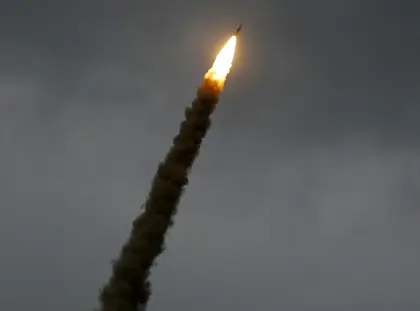While it’s not clear which side fired the Soviet-era missile, the discovery that it had accidentally flown beyond Ukrainian air space and struck the breakaway region of Moldova, is just another example of stray weapons arising from Russia’s long-range bombardment of infrastructure on the Danube River hitting the wrong country.
At least two S-300 missiles, a Soviet-era weapon designed for anti-aircraft work but frequently used by Russian forces in Ukraine for general ground attack, struck in a rural region in eastern Moldova near the village Chitcani, the news platform Perviy Prednestrovskiy said on Monday.
JOIN US ON TELEGRAM
Follow our coverage of the war on the @Kyivpost_official.
Chitcani is in Transnistria, a strip of Moldovan territory along the Dniester River, the pro-Kremlin leadership with Russian army support of which gained de facto independence from Moldova in 1992.
Residents told a TV crew the missile appeared to catch fire above their farm at 1 a.m. and showed craters in their field caused by falling debris. The missile’s warhead did not detonate and officials collected the remnants of the missile later in the day, they said.
Chitcani is located just to the south of the city of Bendery and is less than 15 kilometers from the Ukrainian border. Both the Ukrainian and Russian militaries employ the S-300 missile which has a maximum range of around 400 kilometers. As the armies on both sides currently occupy terrain close enough to Chitcani to make the S-300 strike into Transnistria, either could be responsible.

Rare North Korean Long-Range Cannon Spotted Heading West in Russia
The Kremlin began its long-range bombardment campaign targeting Ukrainian infrastructure, particularly the Ukrainian power grid, in Oct. 2022. Russia’s planners appeared to shift tactics in June to send waves of cruise missiles and kamikaze drones against storage and handling facilities for Ukrainian grain in the Black Sea port cities of Odesa and Chernomorsk, and the towns of Izmail and Reni located upstream on the Danube River.
In recent weeks Kremlin strategists, faced with strengthening Ukrainian air defenses, have routed strikes by dozens of weapons along the Dnieper River itself, which at times skirted Moldovan and Romanian air space by only a few hundred meters.
According to open sources, errant Russian weapons aimed at these Ukrainian targets, or Kyiv’s anti-aircraft weapons attempting to engage incoming Russian weapons, have struck Romanian territory on three occasions and Moldovan territory at least twice since Summer.
The S-300 strike hitting Chitcani in the Moldovan territory of Transnistria was, according to news reports, the first time such an incident had been acknowledged by local authorities.
Almost all countries and international agencies such as the UN consider Transnistria a sovereign part of Moldova and the authoritarian Moscow-installed leadership there to be illegal. Russian officials say Transnistria is a Russian-speaking enclave whose residents would be oppressed by the Romanian-speaking majority in Moldova, were Moldova’s government ever to regain control of the territory.
Romania as a member of NATO enjoys some protection of its air space by its own forces and members of the North Atlantic Alliance.
Neutral Moldova, one of Europe’s poorest states, has no air force aside from a few helicopters. Its protection against incoming drones or cruise missiles is limited to a single battery of 1950s vintage SA-3 anti-aircraft systems.
Correction: A previous version of this article stated Transnistria is located alongside the Danube River. It is in fact the Dniester River. It also said Bendery was the unoffical capital of Transnistria. It is in fact Tiraspol.
You can also highlight the text and press Ctrl + Enter






